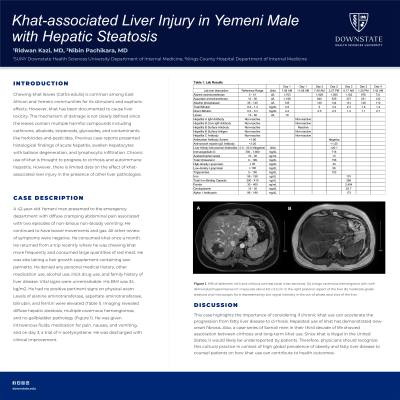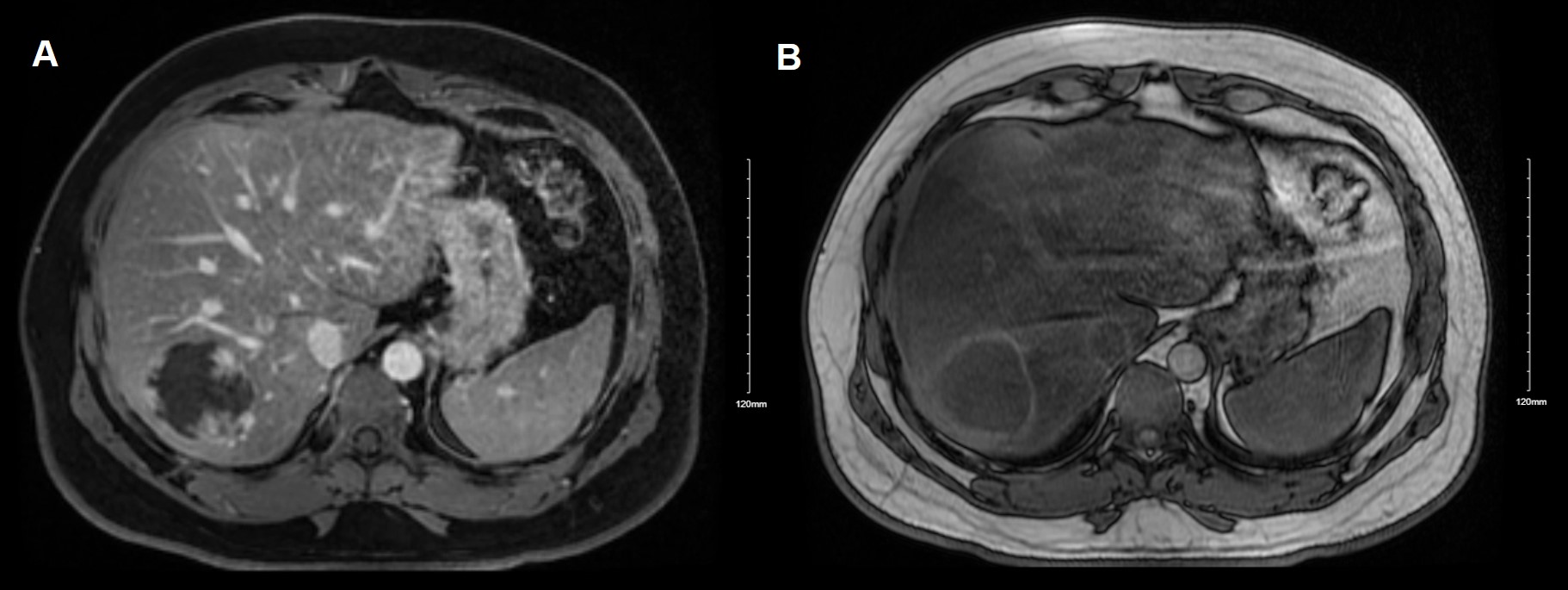Sunday Poster Session
Category: Liver
P1413 - Khat-Associated Liver Injury in Yemeni Male With Hepatic Steatosis
Sunday, October 27, 2024
3:30 PM - 7:00 PM ET
Location: Exhibit Hall E

Has Audio
- RK
Ridwan Kazi, MD
SUNY Downstate Health Sciences University
Brooklyn, NY
Presenting Author(s)
Ridwan Kazi, MD1, Nibin Pachikara, MD2
1SUNY Downstate Health Sciences University, Brooklyn, NY; 2NYC Health + Hospitals/Kings County, Brooklyn, NY
Introduction: Chewing khat leaves (Catha edulis) is common among East African and Yemeni communities for its stimulant and euphoric effects. However, khat has been documented to cause liver toxicity. The mechanism of damage is not clearly defined since the leaves contain multiple harmful compounds including cathinone, alkaloids, terpenoids, glycosides, and contaminants like herbicides and pesticides. Previous case reports presented histological findings of acute hepatitis, swollen hepatocytes with balloon degeneration, and lymphocytic infiltration. Chronic use of khat is thought to progress to cirrhosis and autoimmune hepatitis. However, there is limited data on the effect of khat-associated liver injury in the presence of other liver pathologies.
Case Description/Methods: A 42-year-old Yemeni man presented to the emergency department with diffuse cramping abdominal pain associated with two episodes of non-bilious non-bloody vomiting. He continued to have bowel movements and gas. All other review of symptoms were negative. He consumed khat once a month. He returned from a trip recently where he was chewing khat more frequently and consumed large quantities of red meat. He was also taking a hair growth supplement containing saw palmetto. He denied any personal medical history, other medication use, alcohol use, illicit drug use, and family history of liver disease. Vital signs were unremarkable. His BMI was 34 kg/m2. He had no positive pertinent signs on physical exam. Levels of alanine aminotransferase (ALT), aspartate aminotransferase (AST), bilirubin, and ferritin were elevated (Table 1). Imaging revealed diffuse hepatic steatosis, multiple cavernous hemangiomas, and no gallbladder pathology. He was given intravenous fluids, medication for pain, nausea, and vomiting, and a trial of n-acetylcysteine. He was discharged with clinical improvement.
Discussion: This case highlights the importance of considering if chronic khat use can accelerate the progression from fatty liver disease to cirrhosis. Repeated use of khat has demonstrated new-onset fibrosis. Also, a case series of Somali men in their third decade of life showed association between cirrhosis and long-term khat use. Since khat is illegal in the United States, it would likely be underreported by patients. Therefore, physicians should recognize this cultural practice in context of high global prevalence of obesity and fatty liver disease to counsel patients on how khat use can contribute to health outcomes.

Note: The table for this abstract can be viewed in the ePoster Gallery section of the ACG 2024 ePoster Site or in The American Journal of Gastroenterology's abstract supplement issue, both of which will be available starting October 27, 2024.
Disclosures:
Ridwan Kazi, MD1, Nibin Pachikara, MD2. P1413 - Khat-Associated Liver Injury in Yemeni Male With Hepatic Steatosis, ACG 2024 Annual Scientific Meeting Abstracts. Philadelphia, PA: American College of Gastroenterology.
1SUNY Downstate Health Sciences University, Brooklyn, NY; 2NYC Health + Hospitals/Kings County, Brooklyn, NY
Introduction: Chewing khat leaves (Catha edulis) is common among East African and Yemeni communities for its stimulant and euphoric effects. However, khat has been documented to cause liver toxicity. The mechanism of damage is not clearly defined since the leaves contain multiple harmful compounds including cathinone, alkaloids, terpenoids, glycosides, and contaminants like herbicides and pesticides. Previous case reports presented histological findings of acute hepatitis, swollen hepatocytes with balloon degeneration, and lymphocytic infiltration. Chronic use of khat is thought to progress to cirrhosis and autoimmune hepatitis. However, there is limited data on the effect of khat-associated liver injury in the presence of other liver pathologies.
Case Description/Methods: A 42-year-old Yemeni man presented to the emergency department with diffuse cramping abdominal pain associated with two episodes of non-bilious non-bloody vomiting. He continued to have bowel movements and gas. All other review of symptoms were negative. He consumed khat once a month. He returned from a trip recently where he was chewing khat more frequently and consumed large quantities of red meat. He was also taking a hair growth supplement containing saw palmetto. He denied any personal medical history, other medication use, alcohol use, illicit drug use, and family history of liver disease. Vital signs were unremarkable. His BMI was 34 kg/m2. He had no positive pertinent signs on physical exam. Levels of alanine aminotransferase (ALT), aspartate aminotransferase (AST), bilirubin, and ferritin were elevated (Table 1). Imaging revealed diffuse hepatic steatosis, multiple cavernous hemangiomas, and no gallbladder pathology. He was given intravenous fluids, medication for pain, nausea, and vomiting, and a trial of n-acetylcysteine. He was discharged with clinical improvement.
Discussion: This case highlights the importance of considering if chronic khat use can accelerate the progression from fatty liver disease to cirrhosis. Repeated use of khat has demonstrated new-onset fibrosis. Also, a case series of Somali men in their third decade of life showed association between cirrhosis and long-term khat use. Since khat is illegal in the United States, it would likely be underreported by patients. Therefore, physicians should recognize this cultural practice in context of high global prevalence of obesity and fatty liver disease to counsel patients on how khat use can contribute to health outcomes.

Figure: MRI of abdomen with and without contrast (axial cross-sections): (A) a large cavernous hemangioma with well-demarcated hyperintense rim measures about 6.0 x 5.5 cm in the right posterior aspect of the liver (b) moderate-grade steatosis and microscopic fat is represented by low-signal intensity in the out-of-phase axial slice of the liver.
Note: The table for this abstract can be viewed in the ePoster Gallery section of the ACG 2024 ePoster Site or in The American Journal of Gastroenterology's abstract supplement issue, both of which will be available starting October 27, 2024.
Disclosures:
Ridwan Kazi indicated no relevant financial relationships.
Nibin Pachikara indicated no relevant financial relationships.
Ridwan Kazi, MD1, Nibin Pachikara, MD2. P1413 - Khat-Associated Liver Injury in Yemeni Male With Hepatic Steatosis, ACG 2024 Annual Scientific Meeting Abstracts. Philadelphia, PA: American College of Gastroenterology.
